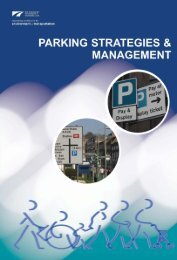Level 2 and 3 Diploma in Business Support (4475-12/13)
Level 2 and 3 Diploma in Business Support (4475-12/13)
Level 2 and 3 Diploma in Business Support (4475-12/13)
Create successful ePaper yourself
Turn your PDF publications into a flip-book with our unique Google optimized e-Paper software.
Unit 207 Pr<strong>in</strong>ciples of work<strong>in</strong>g <strong>in</strong> the public sector<br />
Learn<strong>in</strong>g outcomes <strong>and</strong> assessment criteria<br />
Outcome 1 Know the features of the public sector<br />
The learner can:<br />
1. identify the types of organisations that operate with<strong>in</strong> the public sector<br />
2. identify the ma<strong>in</strong> differences between types of organisations that operate with<strong>in</strong> the public<br />
sector<br />
3. describe the aims of a chosen public sector organisation <strong>and</strong> the wider objectives of the public<br />
sector<br />
4. identify how local <strong>and</strong> central government work together to provide public services<br />
5. state the major differences between the public, private <strong>and</strong> not-for profit sectors<br />
6. identify the key areas of legislation relat<strong>in</strong>g to a chosen public sector organisation.<br />
Outcome 2 Underst<strong>and</strong> how the public sector is structured<br />
The learner can:<br />
1. describe the organisational structure of a chosen public sector organisation<br />
2. expla<strong>in</strong> how a chosen public sector organisation fits <strong>in</strong>to the overall public sector.<br />
Outcome 3 Underst<strong>and</strong> the role of the public sector <strong>in</strong> provid<strong>in</strong>g services<br />
<strong>and</strong> how <strong>in</strong>dividual roles contribute to service provision<br />
The learner can:<br />
1. identify different types of customer for a public sector organisation<br />
2. expla<strong>in</strong> why it is important to underst<strong>and</strong> the needs of a public sector organisation’s customers<br />
3. describe how public service provision can adapt to changes <strong>in</strong> customer needs <strong>and</strong> type<br />
4. expla<strong>in</strong> the purpose of ensur<strong>in</strong>g equality <strong>and</strong> diversity is reflected when provid<strong>in</strong>g public<br />
services<br />
5. expla<strong>in</strong> how <strong>in</strong>dividuals contribute to the work of their organisation <strong>and</strong> the wider public sector.<br />
Outcome 4 Underst<strong>and</strong> f<strong>in</strong>ances <strong>in</strong> the public sector<br />
The learner can:<br />
1. identify where money to pay for public services comes from<br />
2. identify how a chosen public sector organisation is f<strong>in</strong>anced<br />
3. expla<strong>in</strong> why it is important not to waste money <strong>and</strong> resources <strong>in</strong> the public sector<br />
4. expla<strong>in</strong> why prioritisation of public service provision must take place when resources are<br />
limited.<br />
Outcome 5 Underst<strong>and</strong> how public sector organisations work together<br />
<strong>and</strong> with other organisations<br />
The learner can:<br />
1. expla<strong>in</strong> the benefits of work<strong>in</strong>g with other organisations with<strong>in</strong> <strong>and</strong> outside the public sector<br />
2. identify organisations that a public sector organisation works with to provide public services<br />
3. expla<strong>in</strong> how a public sector organisation works with other public <strong>and</strong> non-public sector<br />
organisations.<br />
82 <strong>Level</strong> 2 <strong>and</strong> 3 <strong>Diploma</strong> <strong>in</strong> Bus<strong>in</strong>ess <strong>Support</strong> (<strong>4475</strong>-<strong>12</strong>/<strong>13</strong>)







